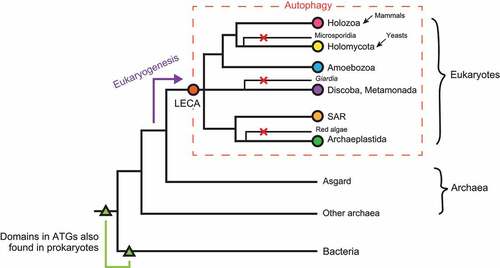Figures & data
Figure 1. The autophagy pathway likely first emerged during eukaryogenesis and was already present in LECA. The phylogenetic tree depicts the overall evolutionary relationships among bacteria, archaea and eukaryotes. The range of species with the autophagy pathway is shown by the orange rectangle. Autophagy losses in some eukaryotes are labeled with red crosses. Some ATG-related domains likely emerged in prokaryotes (green triangles). Mammals and yeasts belong to Holozoa and Holomycota, respectively. LECA, the last eukaryotic common ancestor. ATG, autophagy related. SAR, Stramenopiles, Alveolata and Rhizaria.

